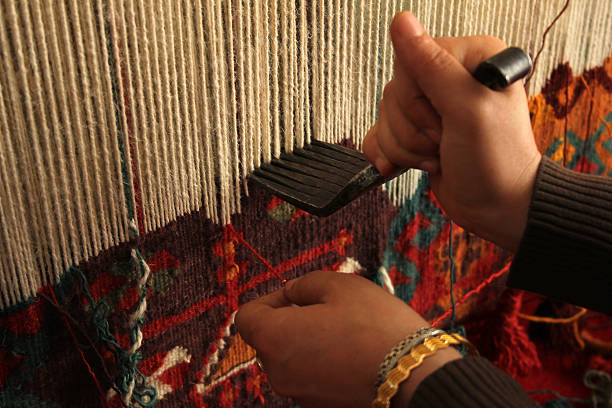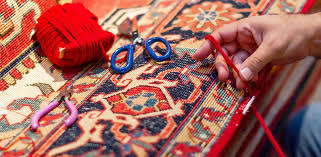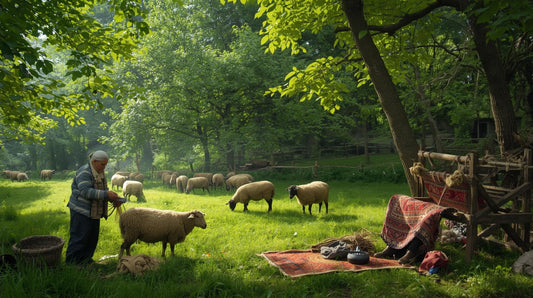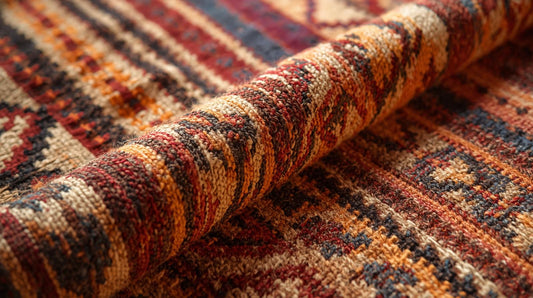Single Knot or Double Knot ?

Can't Decide When Buying a Rug? Single Knot or Double Knot? Here's an Expert's Comprehensive Comparison and Why Double Knot Rugs Should Be Preferred!
In home decoration, rugs play a central role, adding warmth, character, and depth to spaces. Beyond merely being a floor covering, hand-knotted rugs have been considered a cultural heritage and an artistic expression for centuries.1 These artifacts carry the stories, traditions, and artistic languages of the geographies and artisans who wove them. One of the most decisive factors influencing a rug's value, aesthetics, and durability is the type of knot used in its weaving technique. The knotting technique directly affects every characteristic of the rug, from its lifespan to the clarity of its design.
This report provides a detailed comparison of the two fundamental knotting techniques in the world of hand-knotted rugs: the single knot (Persian/Senneh) and the double knot (Turkish/Ghiordes). Its purpose is to help readers understand the differences between these two important knot types and choose the rug that best suits their needs. The fact that rugs are not just objects but also artifacts carrying deep cultural and historical meanings elevates the purchasing decision beyond practical factors like aesthetics or durability. Choosing a rug can also bring with it the desire to acquire a story and a legacy. Understanding this cultural dimension increases interest in the content, positioning this report not just as a source of technical information but as an authority on rug culture. This approach guides consumers in making an informed and valuable choice.
The Importance of the Knot in Hand-Knotted Rugs: Basic Concepts
Hand-knotted rugs are created by tying colorful wool, silk, or rayon threads with different techniques onto a framework of warp (vertical) and weft (horizontal) threads, then compacting them with a tool called a "kirkit".3 These knots form the pile (surface) of the rug, and each knot functions like a "pixel," allowing the rug's intricate patterns to emerge.5
Knot density (KPSI - Knots Per Square Inch), which is the number of knots per square meter, is a critical indicator in determining rug quality, pattern fineness, and durability.2 Generally, a higher knot density indicates more detailed patterns and a longer production time, which increases the rug's cost.2 However, it is important to remember that knot density alone is not the sole indicator of quality. Factors such as the quality of the wool, the naturalness of the dyes, and the overall craftsmanship can be as important, or sometimes even more important, than the knotting technique.7
A common misconception is that high KPSI automatically means the highest quality. However, no matter how high the knot frequency, a rug with poor wool or synthetic dye quality may still have low true value.7 The use of quality materials and natural dyes directly affects the rug's lifespan, color vibrancy, and thus its true value.9 This indicates that consumers should not only focus on a quantitative measure (knot count) but also pay attention to the quality of the materials used (wool, silk, cotton) and the dyes (natural dyes like vegetable dyes). This holistic perspective enables consumers to make a more balanced and accurate assessment of rug quality.
What is a Single Knot (Persian/Senneh Knot)?
The single knot is also known as the Persian Knot, Senneh Knot, or Asymmetrical Knot.8 In this technique, the yarn is wrapped around a single warp thread and loosely wrapped around the other warp.15 One end of the yarn is tied to one warp, while the other end wraps around the weft of the second warp and is left in front.3 This asymmetrical structure causes one side of the knot to remain open.16
Characteristic features of single knot rugs include:
-
Pattern: The single knot allows for finer and more detailed weaves.1 It is ideal for complex, curvilinear patterns, especially floral and botanical motifs, as this knot type offers higher knot density and thus greater "pixel" precision.4
-
Texture: Rugs woven with this technique generally have a softer feel 3 and offer a finer, more intricate woven surface.1
-
Durability: Since it is made with a single knot, it may be less durable than a double-knotted rug.13 It is more prone to pattern loss in case of abrasions or wear.7
The single knot is widely used in Persian rugs, which are also known as Oriental rugs.1 It is also used in other rug-making regions in the Middle East and Central Asia, including Afghanistan and China.8
While single knot rugs allow for finer, more detailed, and complex patterns (especially curvilinear and floral motifs) aesthetically, they are less durable than double knots and carry a higher risk of pattern loss with wear. This indicates that a significant balance must be struck between aesthetic beauty (detailed patterns) and practical functionality (durability) when choosing a rug. It is important for the consumer to consciously consider this balance based on where the rug will be used (a high-traffic living room or a more decorative, low-traffic bedroom). This means that the "best rug" varies according to personal needs and offers the user the opportunity to make a specific, functional, and aesthetically compatible decision.
What is a Double Knot (Turkish/Ghiordes Knot)?
The double knot is also called the Turkish Knot or Ghiordes Knot.1 This technique is created by wrapping the yarn around two warp threads and tightly pulling the loose ends through the warps.15 The ends of the yarn are wrapped behind the two warps and pulled tightly to form a knot.3 Each yarn symmetrically ties around two warp threads.14
Characteristic features of double knot rugs include:
-
Durability: The double knot provides a tighter weave, creating a stronger and more durable rug.3 It increases the rug's durability and prevents the pattern from deteriorating over time.7 It shows superior resistance to abrasions and tears; even if wear occurs, it prevents the pattern from completely unraveling.7 It is ideal for high-traffic areas such as living rooms, hallways, and kitchens.1 It tends to look better and soften over time.1
-
Pattern: It is generally very important in creating the shape of geometric patterns.3 Turkish rugs are characterized by strong geometric patterns, earthy tones, and a tribal feel.1 It creates a thicker and more textured surface.1
-
Texture: It generally creates a more even, full, and plush pile.17
The Turkish knot is commonly found in Turkey, the Caucasus, and Northwest Iran.22 It is also exclusively used in Armenia, Azerbaijan, and certain regions of Iran.16
The strong association of the Turkish knot (Ghiordes) with specific regions like Turkey, the Caucasus, and Northwest Iran indicates that this knot type is not merely a technical feature but also represents a geographical and cultural identity.16 Turkish rugs are stated to be "a way of sharing national stories" and possess "weaving methods passed down for hundreds of years".1 This implies that terms like "Turkish rug" or "Anatolian rug" carry strong brand value in terms of marketing.1 Emphasizing this regional connection conveys the authenticity, cultural depth, and rich history of the products to readers, reinforcing the feeling that they offer not just a product but also a story and a legacy. This approach enriches the content by presenting knot types not merely as technical details but as part of cultural heritage and identity, thereby increasing reader engagement.
Comprehensive Comparison of Single Knot and Double Knot Rugs
In the world of hand-knotted rugs, the knotting technique is more than just a production method; it is a fundamental factor that determines the rug's character, durability, aesthetics, and even investment value. Understanding the differences between single knot (Persian/Senneh) and double knot (Turkish/Ghiordes) is key to making an informed choice. Below is a comprehensive comparison of these two knot types across various characteristics.
Durability and Longevity: Which Knot is Stronger?
The lifespan of rugs and their resistance to wear are directly related to the knotting technique.
-
Double Knot (Turkish Knot): Significantly increases the rug's durability and prevents the pattern from deteriorating over time.7 Its robust structure, formed by tightly wrapping and pulling the yarn around two warps 3, provides superior resistance to tears and abrasions. This ensures that even if the rug wears, the pattern does not completely unravel or disappear.7 Due to these features, double knot rugs are an excellent choice for high-traffic areas such as living rooms, hallways, and kitchens.1 These rugs tend to look better and soften over time, making them a long-lasting investment.1
-
Single Knot (Persian Knot): Due to being gripped from one side while the other side remains independent 13, it may be less durable than a double-knotted rug.13 It is more prone to pattern loss in case of abrasions or tears.7 This indicates that single knot rugs are more suitable for low-traffic or decorative areas.1
These differences reveal that the intended use is a decisive factor in rug selection. A double knot rug is more suitable for heavily used areas like a living room or hallway, while the fine detail advantages of a single knot might be preferred for a low-traffic, more aesthetically focused area like a bedroom or guest room. This distinction helps manage consumer expectations correctly and ensures greater long-term satisfaction with their rug.
Pattern Clarity and Artistic Details: Aesthetic Differences
The knot type directly influences the complexity and artistic detail level of the rug's pattern.
-
Single Knot (Persian Knot): Thanks to its asymmetrical structure, the single knot allows for finer and more detailed weaves.1 This enables the weaver to process complex and curvilinear patterns, especially floral and botanical motifs 6, with greater precision due to higher knot density. Like pixels in a photograph, more knots provide a smoother and less pixelated image.4
-
Double Knot (Turkish Knot): Due to its symmetrical and tight structure, the double knot generally creates a thicker and more textured surface.1 This knot type is very important in creating geometric patterns and tribal motifs.1 It may lead to less intricate designs, but this is a characteristic of the design language rather than a reflection of the rug's quality.4
The fact that the single knot allows for finer and more detailed patterns clearly demonstrates how the knot type shapes the weaver's artistic expression. This can be likened to different brushstrokes an artist might use; each knot type is more suitable for a specific aesthetic language and level of detail. The association of the double knot primarily with geometric and tribal patterns reveals that each knot is more appropriate for a particular aesthetic language. This explains that it is an opportunity rather than a technical limitation underlying the diversity in rug design, and how different knot types foster different artistic traditions.
Texture and Feel: What Difference Does It Make Underfoot?
The texture and feel of a rug underfoot play a significant role in the user's overall experience and spatial comfort.
-
Single Knot (Persian Knot): This knotting technique generally results in a softer rug weave.3 Since it offers a finer and more intricate woven structure, it can leave a more delicate and smooth feel underfoot.1
-
Double Knot (Turkish Knot): Thanks to its tight and symmetrical structure, double knot rugs create a thicker and more textured surface.1 They generally form a more even, full, and plush pile, offering a denser and firmer feel underfoot.17 This can be a preferred choice, especially for those seeking comfort and fullness in high-traffic areas.
The tactile experience of a rug is crucial for overall consumer satisfaction. The "soft" nature of the single knot and the "thick and textured" nature of the double knot offer different advantages depending on personal preferences and the atmosphere of the room where the rug will be used. For example, softness might be prioritized in a bedroom, while a full and firm feel might be preferred in a living room. This emphasizes that a rug should be evaluated not only by its appearance but also by its tactile properties, highlighting the importance of meeting the consumer's sensory expectations.
Production Process and Craftsmanship: Time and Labor Factor
The production process of hand-knotted rugs is highly labor-intensive and time-consuming compared to machine-made rugs.
-
General: Hand-knotted rugs are generally more expensive due to the difficulty and time-consuming nature of the production process.21 Each knot being tied by hand makes these rugs "labor-intensive" products.2 Tying thousands, even millions, of knots by hand can take months, even years.2 This long production time directly reflects on the rug's final price.2
-
Double Knot (Turkish Knot): It is a type of knot made on two warps.3 The ends of the yarn are wrapped behind two warps and quickly pulled.3 Some sources indicate that the double knot, being a relatively simpler tying style, can provide efficiency in large-scale rug production 18, but this does not compromise the rug's handmade quality.
-
Single Knot (Persian Knot): Two warp threads are used.3 It is wrapped around a single warp thread and loosely wrapped around the other warp.15 Since it allows for finer and more detailed weaves, it may require the weaver to show more precision and attention, which can extend the production time.
The primary reason hand-knotted rugs are generally expensive is the difficulty and time-consuming nature of their production process.2 Each knot being tied by hand 2, especially in rugs with high knot density, significantly increases the production time and thus the cost.2 This helps consumers understand that the price they pay comes not only from the materials used but also from the intense labor and artistic skill involved. Furthermore, it can be emphasized that due to their handmade nature, each hand-knotted rug may have minor imperfections (different knot sizes, slight irregularities), and these imperfections are actually proof of the rug's "uniqueness" and "originality".12 This reinforces the value and uniqueness of hand craftsmanship when compared to the fact that machine-made rugs have single knots or no knots at all.11
Value and Price Differences: Investment Potential
Hand-knotted rugs, especially high-quality ones (including double-knotted), can be seen as "investments" that can retain or even increase their value over time, rather than just decorative items.
-
General: Hand-knotted rugs are generally more expensive due to the labor-intensive nature of their production.2 As knot density increases (requiring more labor and time), the price of the rug also increases.2 The quality of materials (high-quality wool, silk, natural dyes) directly affects the rug's price, durability, and long-term value.2
-
Investment Potential: Antique (100 years and older) and vintage (20-100 years old) hand-knotted rugs can retain or even increase their value when stored and cared for properly.9 Factors such as rarity, unique designs, good condition, and known provenance significantly influence a rug's investment potential.10
-
Double Knot (Turkish Knot): Can generally offer more affordable options 1, while maintaining the same quality, and intermediary costs can be reduced when sourced directly from sellers.1 Due to its suitability for high-traffic areas and superior durability, double knot rugs are seen as a practical and potentially heirloom-worthy investment that can be passed down through generations.1
-
Single Knot (Persian Knot): Can generally have higher price tags, especially those with silk weaves and extremely complex, finely detailed patterns.1 They may be rarer and more sought-after by collectors, but their value can fluctuate depending on market trends and demand.9
-
Price Examples: Price ranges for double-knotted wool rugs of 8x10-9x12 feet are stated to be between $1600-$4000.28 Prices for various double-knotted rugs range widely from $236.40 to $6,899.20.29
The transformation of rug acquisition from a consumption act to a strategic investment, especially for hand-knotted and high-quality pieces, clearly demonstrates that they can be "investments" that retain or even increase their value over time.9 This helps shift the consumer's perspective from "spending" to "a wise investment." The fact that double-knotted Turkish rugs are "practical and potentially heirloom-worthy" 1 emphasizes this investment potential. This allows consumers to consider not only immediate aesthetic satisfaction but also long-term financial and cultural returns. The report details how factors such as the rug's age, condition, material, knot quality, and market demand affect its value.10
Table 1: Comparison of Single Knot (Persian/Senneh) and Double Knot (Turkish/Ghiordes) Rugs
The table below summarizes the key differences between single knot and double knot rugs, allowing the reader to make a quick and clear comparison. This table visually organizes information scattered throughout the text, providing an invaluable tool, especially for readers seeking quick information or in the decision-making phase. Such well-structured and easily digestible content encourages readers to stay on the site longer and interact more with the content.
|
Feature |
Single Knot (Persian/Senneh Knot) |
Double Knot (Turkish/Ghiordes Knot) |
|
Other Names |
Persian Knot, Asymmetrical Knot |
Turkish Knot, Symmetrical Knot |
|
Knotting Technique |
Wrapped around a single warp thread (one end remains loose) 15 |
Tightly wrapped around two warp threads (both ends are secured) 3 |
|
Durability |
Less durable than double knot, more prone to wear 13 |
Very durable, long-lasting, superior resistance to wear 7 |
|
Pattern Type |
Ideal for fine, detailed, floral, curvilinear, complex motifs 1 |
Ideal for strong, distinct, geometric, tribal motifs 1 |
|
Texture/Feel |
Softer, finer, and more delicate texture 1 |
Thicker, more textured, and fuller pile 1 |
|
Common Regions |
Iran, parts of Middle East and Central Asia, Afghanistan, China 1 |
Turkey, Caucasus, Northwest Iran, Armenia, Azerbaijan 16 |
|
Resistance to Wear |
High risk of pattern loss with wear 7 |
Retains pattern integrity even with wear 7 |
|
Suitable Use Area |
Low-traffic, decorative, or formal areas (bedroom, wall hanging) 1 |
High-traffic areas (living room, hallway, kitchen) 1 |
|
General Price Trend |
Can generally be more expensive (especially silk and highly detailed) 1 |
Can generally offer more affordable options (varies by quality) 1 |
Why Do Experts Recommend Double Knot Rugs?
The primary reasons why rug experts and collectors often prefer double-knotted rugs lie in the superior characteristics offered by this knot type. These features cover a wide range, from the rug's lifespan to its aesthetic appearance, and even its potential investment value.
Ideal Solution for High-Traffic Areas
Double knot rugs, thanks to their robust and tight weave structure 3, are an excellent choice for high-traffic areas such as living rooms, hallways, entryways, and kitchens.1 These rugs can maintain their shape and beauty for many years despite heavy use, making them ideal for the busiest spots in your home. Especially Turkish rugs, which are a wool-cotton blend, offer extra durability in high-traffic areas.1 The determining role of intended use in rug selection is clearly demonstrated by the superior performance of double-knotted rugs in these areas.
Pattern Preservation and Superior Resistance to Wear
The double knot increases the rug's durability and prevents the pattern from deteriorating over time.7 Rugs produced with this knotting technique show superior resistance to abrasions and tears. One of their most significant advantages is that even if wear occurs, it prevents the pattern from completely unraveling or disappearing.7 This feature ensures that the rug's aesthetic integrity is preserved for a much longer period.
Long-Term Value and Heirloom Potential
Double-knotted hand-knotted rugs are considered not just a floor covering but potentially valuable investments that can be passed down from generation to generation, becoming heirlooms.1 Double-knotted rugs, woven with quality materials and craftsmanship, can retain or even increase their value over time.9 Especially Turkish rugs, when sourced directly from sellers, can offer more affordable options without compromising on quality.1 This makes them an attractive choice both practically and financially. The transformation of rug acquisition from consumption to a strategic investment is supported by the long-term returns offered by double-knotted rugs.
Conclusion and Recommendations
The differences between single knot and double knot rugs highlight the unique advantages and ideal uses of each knot type. Single knot (Persian/Senneh) rugs offer artistic richness with their fine and detailed patterns, especially in floral and curvilinear motifs, and are appealing to those seeking a softer texture. However, in terms of durability, they can be more delicate than double knots and may carry a risk of pattern loss in high-traffic areas.
On the other hand, double knot (Turkish/Ghiordes) rugs offer superior durability and longevity with their robust and tight structure. Thanks to their resistance to wear and ability to preserve pattern integrity, they are ideal for high-traffic living spaces. Characterized by geometric and tribal patterns, double-knotted rugs tend to improve with age and potentially carry heirloom value that can be passed down through generations.
In summary:
-
If you plan to use your rug in a high-traffic area (living room, hallway, kitchen) and are looking for a long-lasting, durable investment, double knot (Turkish/Ghiordes) rugs will be the most suitable option for you. These rugs offer a perfect combination of practical use and long-term value.
-
If you intend to use your rug in a low-traffic, decorative, or formal area (bedroom, wall hanging) and your priority is fine, intricate, floral patterns and a softer texture, you can opt for single knot (Persian/Senneh) rugs. These rugs will add a unique aesthetic to your space with their artistic details and delicate feel.
It should be remembered that while knot density is an important indicator of quality, the true value of a rug is a whole, encompassing other factors such as the quality of the wool used, the naturalness of the dyes, and the overall craftsmanship. Therefore, considering all these elements when choosing a rug will ensure that you acquire a piece that meets your aesthetic expectations and that you will enjoy for many years. An informed choice allows you to establish a strong connection with your rug and become part of its cultural story.
No comments







0 comments